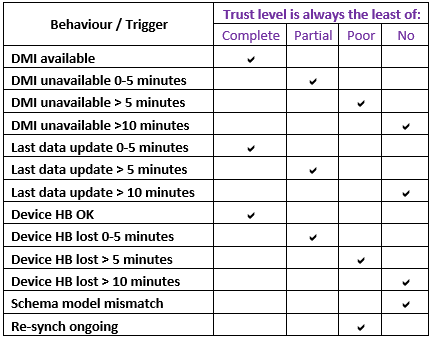| Table of Contents |
|---|
Related Jira(s)
...
- Currently only supporting NONE and COMPLETE. PARTIAL and POOR may be added later as below.
Changes to DMI Registry Model
...
- .
Triggers of CMHandle trust level change
DMI Availability
Ping every 30 seconds configurable or (every communication with DMI OOS)
Health check endpoint already exists
http://'$1'/manage/health/readiness
Hazelcast Map
When DMI comes back up, DMI does audit and provides list of Trustworthy CM Handles
Audit triggered by NCMP with list of CMHandles IDs and for DMI to reregister HTTP
Deltas: DMI handling, properties; Delete all under a DMI? Performance?
...
Device Heart Beat
Assumed functionality is that this will be defined by the DMI Plugin as NCMP does not communicate with device directly
Interface in NCMP for DMI Plugin to be able to tell when device HB has been lost?
10 minute limit should be configurable with 10 as default.
Probably event based
...
DMI-I-01
/health
/v1/ch/trustlevel
{
"Trust":
}
Reregistration
- This process occurs when the DMI Plugin Availability is down and then comes back up.
- NCMP makes a synchronous call to the DMI Plugin (New Audit Endpoint) to trigger a reregistration
- DMI Plugin then reregisters its CMHandles with NCMP (new reregistaration Endpoint?)
- NCMP then compares the CMHandles which are being reregistered with the CMHandles which already exist.
- CMHandles which are in NCMP but not in DMI reregistration request are kept as trust level none
- What happens if there is conflict between the old and new properties of a CMHandle, just take the new properties?
- New CMHandles could be registered
...
Hazelcast for Trust Level
...
...
...
Set Trust level for untrustworthy CMHandles
Key: CmHandleId
When checking the trust level for a CMHandle first check the trust level of that CMHandle's DMI Plugin
If None return None
If Full check trust level for the CMHandle and return that
High Level Interactions
| Drawio | ||||||||||||||||||||
|---|---|---|---|---|---|---|---|---|---|---|---|---|---|---|---|---|---|---|---|---|
|
| Interface | Name | Trigger | Description | Type | Endpoint or Topic | Schema |
|---|---|---|---|---|---|---|
| 1 | HealthCheck | 30 second interval (configurable) | NCMP is to perform a health check against each of the DMI Plugins | REST | http://'$1'/manage/health/readiness | |
| 2 | Reregistration request | DMI Plugin has gone down and comes back up | NCMP makes a call to that DMI Plugin telling it to reregister | REST | TBD | |
| 3 | Reregistration | DMI Plugin received a reregistration request | DMI Plugin makes a call to NCMP to reregister its CM Handles | REST | /v1/ch/reregistration | {
"dmiPlugin": "my-dmi-plugin",
"dmiModelPlugin": "my-dmi-model-plugin",
"cmHandles": [
{
"cmHandle": "my-cm-handle",
"publicCmHandleProperties": {
"key": "my-property"
},
"cmHandleProperties": {
"key": "my-property"
}
},
{
"cmHandle": "my-cm-handle",
"publicCmHandleProperties": {
"key": "my-property"
},
"cmHandleProperties": {
"key": "my-property"
}
}
],
"dmiDataPlugin": "my-dmi-data-plugin"
} |
| 4 | CMHandle trust level change | A CMHandle managed by DMI Plugin's trust level has changed | data contains {trustLevel: ENUM} event id is cmhandle id | Kafka | TBD | <cloudEvents-header> id : <cmhandleId> type : org.onap.cm.events.trustlevel-notification data : { trustlevel : "COMPLETE" } |
| 5 | TrustLevel Request | Client Request | TrustLevel is to be returned based on the values in above Maps | REST | TBD |
Managing TrustLevels
DMI Plugins
- NCMP is checking every DMI Plugin for health at interface 1 every 30 seconds using the DMI Trust Map
- IF a DMI Plugin goes down, that DMI Plugin's trust level is updated to NONE in the DMI Trust Map
- IF a DMI Plugin comes back up, NCMP requests that DMI Plugin to do a reregistration via interface 2
- That DMI reregisters itself using interface 3
- NCMP analyses the registration and compares the CMHandles it knows about to the CMHandles which have been reregistered, any CMHandles which did exist and are not reregistered are now added to the untrustworthy CMHandles Map. Existing CMHandles are updated and new ones are created.
- After the reregistration is complete, the DMI Plugin TrustMap is updated to set the trust level for that DMI to complete.
CMHandles HB
- It is the responsibility of the DMI Plugins to update NCMP about the HBs of CMHandles
- Through interface 4, DMI Plugins will provide a kafka event on the changing of trustworthiness state of a CMHandle.
- NCMP receives this event and updates the Untrustworthy CMHandles Map accordingly
Reading Trust Level
- Body of request to be discussed, Will the request provide a DMI or a list of CMHandles?
- Interface 5
- NCMP will first check DMI Trust Map for the CMHandle
- If that DMI which is managing the CMHandle is marked as untrustworthy then we return NONE without checking the Untrustworthy CMHandles Map
- If that DMI is trustworthy, we check the individual CMHandles Map, if the CMHandle is in the Map then return NONE.
- Logically IF (DMITrustMap.getDMIPlugin.getTrustLevel == NONE) Return NONE
- ELSE (IF UntrustworthyCMHandlesMap.getDMIPlugin.contains(CMHandle) RETURN NONE
- ELSE return COMPLETE
